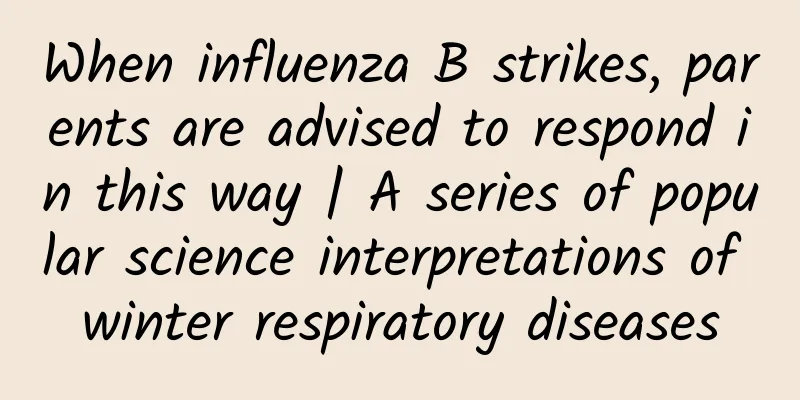When influenza B strikes, parents are advised to respond in this way | A series of popular science interpretations of winter respiratory diseases

|
Editor's note: Recently, Guangming Online's Science Channel and the "Dayi Xiaohu" medical communication think tank launched a special topic called "Winter Respiratory Disease Series Popular Science Interpretations", inviting medical experts to provide popular science interpretations on the causes, transmission routes, prevention measures and treatments of respiratory diseases. Please pay attention. Author: Zhang Xinlin, Yueyang Hospital of Integrated Traditional Chinese and Western Medicine, Shanghai University of Traditional Chinese Medicine Scientific review: Shen Jian, Yueyang Hospital of Integrated Traditional Chinese and Western Medicine, Shanghai University of Traditional Chinese Medicine Winter is a time when many respiratory diseases alternate or co-circulate. Recently, influenza B has surpassed influenza A and mycoplasma, and has frequently appeared on the hot search list. Many parents have questions, "How can my child get influenza B after recovering from influenza A?" "What is the difference between influenza B and influenza A? Are the treatment drugs the same?" Don't worry, take a look at this article with these questions. What is influenza B? Influenza B (abbreviated as HBsAg) is a type of influenza virus that causes influenza. Influenza viruses can be divided into three types: A, B, and C, and HBsAg is one of them. The latest issue of the "Weekly Influenza Surveillance Report" (December 25-December 31, 2023) released by the National Influenza Center on January 4 showed that the proportion of influenza A H3N2 strains, which previously dominated transmission, has dropped significantly, but the proportion of influenza B strains has increased significantly, with influenza B accounting for 26.4% in the south and 47.3% in the north. Similarly, the number of children with influenza B in the pediatric fever clinic of our hospital has increased recently compared with the previous few weeks. Image source: China National Influenza Center If I have recovered from influenza A, will I get influenza B again? The question that parents are most concerned about is, after recovering from influenza A, will children be infected with influenza B again? The answer is yes. Influenza B and influenza A are two different subtypes of influenza and do not have a cross-immunity mechanism. Generally speaking, the possibility of being infected with the same subtype of influenza virus within a year is small, but influenza A virus is easy to mutate, and influenza B has two strains, Victoria and Yamagata. Even if a child has been infected with influenza A or B, if the physical condition is relatively weak, and there are many people in the class or family who have influenza, then there is still a possibility of being infected with another subtype of influenza virus again, and the possibility of overlapping infection exists. This also reminds us that if children show flu-like symptoms, we must not be careless and should seek medical treatment in time and get tested for influenza as early as possible. What are the typical symptoms of influenza B? The incubation period of influenza B is usually 1 to 4 days. It is characterized by rapid onset, rapid changes, chills, fever, and a rapid rise in body temperature within a few hours to 24 hours, reaching 39°C to 40°C, or even higher. It is also accompanied by other symptoms, such as headache, dizziness, body aches, fatigue, and loss of appetite. Respiratory symptoms are mild, but they may occur, such as sore throat and dry cough. What are the differences between influenza B and influenza A? Influenza B and influenza A have similar infectivity. In terms of the scope of transmission, influenza A can infect humans, mammals and birds, and its antigens mutate frequently, making it highly contagious and more likely to cause a large epidemic. Influenza B only infects humans and is relatively less prevalent. The two have similar symptoms of "high fever, muscle aches, headaches, and general fatigue". Influenza B is also accompanied by gastrointestinal manifestations such as vomiting, abdominal pain, and diarrhea, which are more common in children and adolescents. Of course, it is easier to distinguish between the two with testing. How is influenza B treated? After the diagnosis of influenza B, anti-influenza virus drugs should be given as soon as possible. The golden period for influenza treatment is 48 hours after the onset of the disease. If the child continues to have a high fever, or has a poor resistance, or the influenza is not detected in time, even if it has been more than 48 hours, it can still be considered for use and still benefit. Currently, the first choice of effective drug is oseltamivir. The appropriate dosage form and correct dosage should be selected according to the child's age and weight. It is recommended to take it for 5 days as a course of treatment. It can effectively inhibit and block the replication of influenza virus. Pay attention to the safety of medication and it is recommended to use the medication under the guidance of a doctor. In addition, the new anti-influenza drug, Mabaloxavir (trade name: Sufoda), has gradually come into everyone's view. Children with influenza B have more obvious symptoms of vomiting, abdominal pain, and diarrhea. Compared with oseltamivir, Sufoda has less gastrointestinal irritation and requires fewer doses and days of use, so it is favored by parents and friends. However, parents and friends should also be reminded that Sufoda is not a "magic drug" and also has side effects. It should be used with caution under the guidance of a doctor. As the holidays approach, how can children prevent influenza B? After the exam week, the long-awaited winter vacation and Spring Festival are coming. Will influenza B disappear? What should children pay attention to during the holidays? Wear masks scientifically. Children should wear masks scientifically and take personal protection measures in crowded public places, shopping malls, bus stations and when taking public transportation. Maintain good personal hygiene habits, such as washing hands frequently, disinfecting hands in time, and avoiding contact with patients with respiratory infections. Maintain good respiratory hygiene habits, cover your mouth and nose with your upper arm or tissue or towel when coughing or sneezing, wash your hands after coughing or sneezing, and try to avoid touching your eyes, nose or mouth. If you have flu-like symptoms, you should take a rest, stay at home for health observation, and do not go to class or play when you are sick. Family members should also take precautions, ventilate the room and disinfect items to avoid cross infection. Before traveling during the holidays, parents should not forget to bring some basic medicines and first aid supplies, including commonly used antipyretics, cold medicines, cough medicines, antidiarrhea medicines, etc., to prevent some emergencies. I hope the children can have a smooth exam week and happily welcome a wonderful holiday! |
>>: Can stones heal themselves without treatment?
Recommend
What are the harms of spontaneous abortion to the body?
Human miscarriage can be divided into two types: ...
Is it a disease to dislocate the jaw when yawning? Why does the jaw drop when yawning?
I believe many people have seen on Weibo that Huo...
What to do if pregnant women have itchy toes
Considering the special physical conditions after...
How to replenish your body after taking birth control pills
Many couples nowadays want to enjoy a period of t...
How can women delay aging?
We all know that what women worry about most is a...
What are the methods for checking uterine prolapse?
Prolapse is usually a gynecological disease, whic...
Is vulvar leukoplakia easy to treat?
Women will feel particularly scared after contrac...
Can vaginitis cause irregular menstruation?
Vaginitis is a common gynecological disease among...
Will the fetus enter the pelvis if it is in an abnormal position? Pregnant mothers must watch
Malposition of the fetus is a common phenomenon. ...
Brown leucorrhea after menstruation
Women's menstruation has certain regularities...
What kind of cigarettes are better for girls?
Smoking is not just a right for boys nowadays. So...
Why does a rainbow appear after rain? How is a rainbow formed?
A rainbow is a complete circle, with the center b...
Bleeding again after one week of stopping bleeding
People choose abortion based on subjective and ob...
A complete picture of a woman's right hand with a mole
Complete collection of illustrations of moles on ...
What delicacies can be made with chocolate? Can chocolate make you gain weight?
Chocolate not only tastes delicate and sweet, but...









